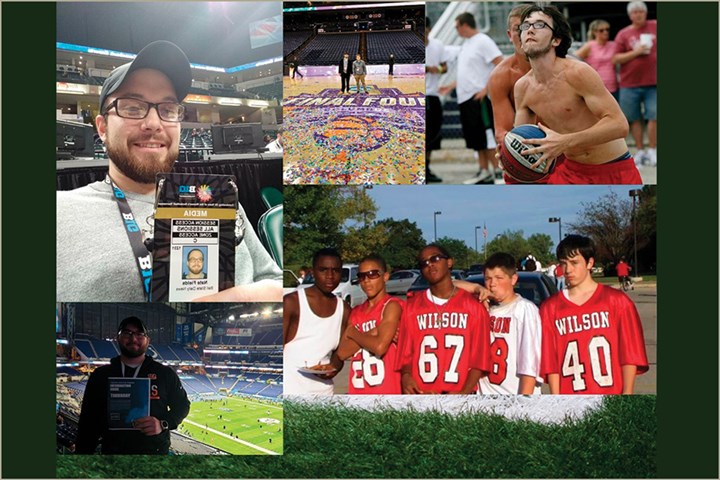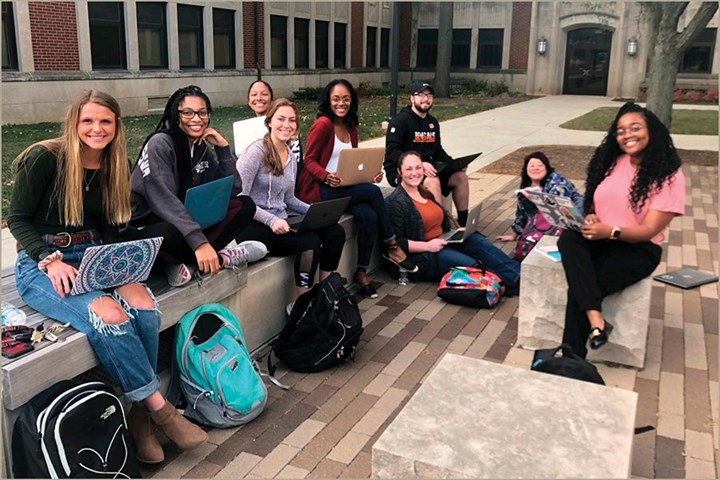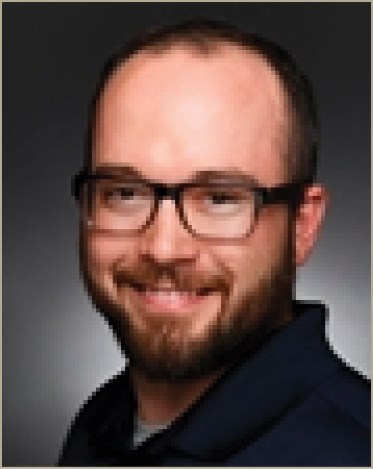Getting Comfortable Outside of my Comfort Zone
Digital Assistant Editor Nate Fields describes his path toward working in the manufacturing industry.
#copywriting
Employee Spotlight Profile
Nate Fields, Digital Assistant Editor
Sports have always been a mainstay in my life. They’ve provided me with a source of passion and emotion. That’s probably a commonality for people in sports whose home lives resembled mine: dysfunctional, to put it nicely. Sports — specifically basketball and football — provided an escape, whether through watching on TV or playing. They were my first comfort zone.
I also found an affinity for writing during my teenage years. I swapped out a standard English class for a poetry class during my junior year of high school, and my poetry teacher told me I should write rap lyrics because I had a knack for finding rhymes when writing poetry.
Obviously, rapper and athlete were never really on the table as career choices, unfortunately. How else could I make a living doing the two things I most enjoyed?

Whether for work or leisure, I always kept sports close by.
Duh! I’ll become a sports reporter and cover a professional team one day.
Easier said than done, but that was my dream.
After nearly flunking out of high school on several occasions due to skipping school consistently and never doing my homework, my grades were far too low to get considered by even the least prestigious universities.
So, it was on to community college, where I essentially had to redo high school. With the factors of my home life mostly remedied by finally living on my own, I was able to focus and, for the first time since probably early elementary school, I was excelling academically.
I completed those requirements and transferred to Ball State, where I studied news journalism and telecommunications. Between taking 15-19 credit hours each semester, working at the student newspaper as a sports editor and working approximately 30 hours per week at Menards part-time, it was a grind, but I finally earned my bachelor’s in 2018 after two years of that routine.
The job search was surprisingly easy. I’m single and had already learned that there were no real career opportunities in my hometown of Muncie, Indiana, a smaller city of 70,000 people about 45 miles northeast of Indianapolis. With those factors, I was able to expand my job search to a nationwide one.
After applying to about 20 jobs, I got an offer to cover sports in a very small city in Missouri, about two hours south of St. Louis.

An enthusiastic me sitting at my desk during the first day of my first newspaper internship in 2018.
This job was anything but the glamorous sports life I had imagined as a teenager. My salary was just $29,000, and between writing, taking photos (I won my first professional award during this time, an Associated Press Media Editors award for sports photography), designing pages, making videos and traveling with the junior college basketball program I covered, it felt like the work I did was worth far more than the $850 I was taking home every two weeks after leaving behind my friends and everything I’d ever known to go do this.
After a year on the job, sports ending for the summer and an expiring lease on the house I rented, I began a job search again and planned my first real vacation in about five years. I planned my vacation around several job interviews and, in July 2019, received an offer to cover Western Kentucky University sports in Bowling Green, Kentucky. The offer? The same pay to go live in a more expensive city to do more demanding work.
I was still excited because I loved sports, but I couldn’t help but think, I put in all this work to barely be able to pay my bills? Despite my objections, that’s the state of the journalism industry these days. You’re overworked, underpaid, and there’s always a line of enthusiastic graduates who haven’t yet had the life sucked out of them and are desperate for a chance to do what you’re doing. For me, something had to change.
Before finishing undergrad, I had juggled around the idea of going to graduate school and earning a master’s in public relations to work in sports PR. I had already sent in my statement of interest and fulfilled all the program’s requirements at Ball State, but I didn’t have an assistantship to help with tuition costs.
Oddly enough, I had to check my school email to manage some subscriptions I had used that email to set up. In my inbox, I found that my program director had sent me an assistantship opening. So I thought, what the hell? I never check this email, which means I’m surely meant to apply for this position. After throwing in my application and briefly interviewing with the team, I received an offer to work for the university’s nursing school as a graduate assistant.
It was time to go back home.
I enrolled in PR graduate courses, studying loads of communications theory, analytics and more. I still wanted to work in sports, so I applied to almost any internship I could find. Finally, the Sky, Chicago’s WNBA franchise (which just won the WNBA Finals last month), reached out to set up an interview for a PR intern role for their 2020 season. I received the offer during the phone interview, which lasted maybe 30 minutes. Around the same time, I had been accepted into Ball State’s study abroad program that sends journalism students to cover The Olympics every two years. I was going to spend two weeks in Tokyo covering the best athletes in the world and work for a professional basketball team.

Me and my graduate program cohort during a class session outside.
This was the break I needed to catapult my career to the next level.
Suddenly, it was all gone.
A week before I was scheduled to start my internship in late March 2020, COVID-19 had reached the United States, and the NBA and WNBA both halted their seasons, thus canceling my internship. Ball State followed by canceling all study abroad programs until further notice.
Out of work, out of my comfort zone and with no direction, I was heartbroken, depressed and basically any other negative emotion you want to throw into that bunch. My assistantship contract expired in May, and I was denied unemployment despite nearly every business being shut down.
Down to 38 cents in my bank account, I was forced to DoorDdash full-time all summer to pay my bills until school resumed, my second assistantship contract started and I could get financial aid. Despite everything I had experienced during childhood, this was the lowest point of my life. All my hard work had been undone by a once-a-century catastrophe I had no control over.
I feel selfish writing this knowing I still have my health and never lost any loved ones to COVID-19, but all my hard work was undone by something I couldn’t control, costing me once-in-a-lifetime opportunities. It taught me a lot about being adaptable.
Knowing I’d likely never work in sports again, or at least anytime soon, I thought maybe pivoting to university work would bring me a new purpose and meaning. After interviews with countless universities, I received a whopping zero job offers.
With the end of my master’s program on the horizon and apparently zero prospective employers being impressed by my experience or the 3.97 GPA I had in grad school, it was time to get even further outside of my comfort zone.
I saw a listing for an assistant digital editor position at Gardner Business Media, a company I had no familiarity with, but again came that thought: What the hell? I don’t know the first thing about manufacturing or metalworking, but I have a digital and editorial skillset and am a quick, willing learner, so I threw in an application just to add to my list.
After a couple of laid-back interviews, it struck me as a tight-knit place where maybe I’d fit in, so I accepted the job offer I’d received on my birthday, April 30. It was time to move again and live in my third new state since late 2018.
It has been an adjustment, moving away from my friends to a less familiar place where I don’t know anyone yet again, but I’ve finally gotten comfortable outside of my comfort zone. Although I’m still not over losing those opportunities, I’m getting there with the help of the people around me.
Despite not having a manufacturing background, I have a team of people I can rely on to make sure I find my way, learn this industry and try to find meaning in my work again. Whether I’m talking to one of the many people on my digital team who always has an interesting idea or new tactic to try out to succeed in our work or an experienced writing editor who will help me grasp the more technical side of our content while also providing their strategic insights, the resources here for me to expand my comfort zone seem endless.
It’s safe to say this is the best work culture I’ve ever been around in my short career, so I hope this is my new comfort zone for the foreseeable future, where I can continue to learn this industry and connect our audience with our work.
Need more information?
Nate Fields, Digital Assistant Editor
Gardner Business Media, Inc.
Twitter
LinkedIn
800-950-8020
About the Author
Nate Fields
Nate is a digital assistant editor at Gardner Business Media. He helps with digital efforts and website management for Modern Machine Shop magazine. He has formerly worked as a sports reporter. Nate is originally from Muncie, Indiana, and has a B.A. in news journalism and a M.A. in public relations from Ball State University.
In his limited spare time, Nate likes to watch sports and play basketball. As a newer Cincinnati resident, he also enjoys exploring the city and trying all the new food options he can find. He is an avid hip-hop fan, always looking out for new music from artists like Smino, Mick Jenkins, Isaiah Rashad and many more. Nate also enjoys stand-up comedy and TV shows like It’s Always Sunny in Philadelphia.
RELATED CONTENT
-
26 Relevant Print Marketing Statistics: 2022 Ad Spending & Impact
Print marketing is not dead. Its impact on consumer brand recall and purchase decision is worth considering, especially if you want to implement an integrated, multi-channel approach to your marketing strategy. This article on marketing trends and predictions can provide more insights on strategies you can use for your business or marketing clients.
-
Understanding Brand Affinity
An approach that seems to help understand customer behavior regarding brand loyalty and insistence is the work done by experts who look at customer brand involvement as a combination of involvement and emotional content. An understanding of customer behavior finds that insistence for brands will vary based on either the brand's personality or the brand's reflection of the buyer's personality. There is an important distinction between identification with a brand and a belief that the brand identifies with you.
-
10 Truths About Marketing After the Pandemic
The Covid-19 pandemic upended a marketer’s playbook, challenging the existing rules about customer relationships and building brands. One year in, there’s no going back to the old normal. Here are 10 new marketing truths that reveal the confluence of strategies, operations, and technologies required to drive growth in a post-Covid-19 world.


